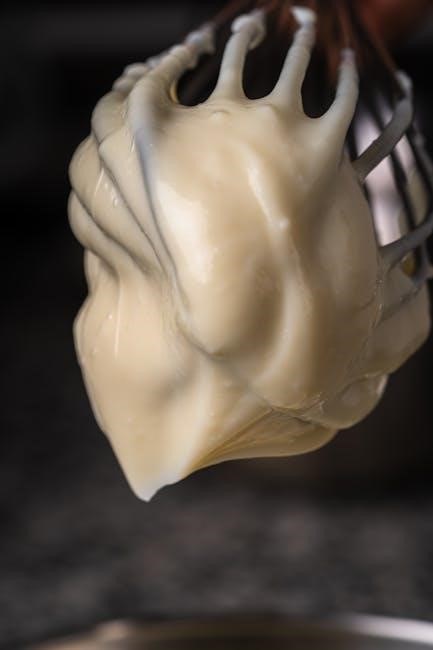Mixing Sermorelin 2mg requires precision and care to ensure the solution is safe and effective․ Proper techniques prevent contamination and maintain potency for optimal results․
Overview of Sermorelin
Sermorelin is a synthetic growth hormone secretagogue that stimulates the pituitary gland to release natural growth hormone․ It is commonly used to treat growth hormone deficiency and promote healing․ Typically administered via subcutaneous injection‚ Sermorelin is available in lyophilized form and requires reconstitution with bacteriostatic water․ The 2mg vial is a standard concentration‚ with dosages ranging from 200-300 mcg‚ often taken before bedtime to mimic natural hormone release patterns․ Proper reconstitution and storage are crucial for maintaining its efficacy and safety․
Importance of Proper Mixing Techniques
Proper mixing of Sermorelin 2mg ensures the solution’s stability and effectiveness․ Incorrect techniques can lead to contamination or uneven distribution‚ reducing potency․ Using sterile equipment and precise water volumes maintains safety and prevents degradation․ Gentle handling avoids foam formation‚ which can disrupt accurate dosing․ Proper mixing also ensures the solution is clear and ready for administration‚ maximizing therapeutic benefits and minimizing potential side effects․ Adhering to guidelines is essential for achieving optimal results and maintaining the integrity of the medication․
Materials Needed for Mixing Sermorelin 2mg
- Sermorelin vial
- Bacteriostatic water
- Mixing syringe
- Needle
- Alcohol wipes

Sermorelin Vial
The Sermorelin vial contains the active peptide in lyophilized form‚ requiring reconstitution with bacteriostatic water․ Ensure the vial is sealed and stored properly before use․ Always handle the vial with clean hands or gloves to prevent contamination․ The vial should be inspected for any visible damage or cracks before proceeding with the mixing process․ Proper storage conditions‚ such as refrigeration‚ are crucial to maintain the integrity of the Sermorelin until it is ready for use․
Bacteriostatic Water
Bacteriostatic water is a sterile‚ non-pyrogenic solution used to reconstitute the Sermorelin peptide․ It contains a bacteriostatic agent‚ typically benzyl alcohol‚ to prevent microbial growth․ This water is essential for maintaining the stability and potency of the Sermorelin solution․ Always use bacteriostatic water specifically designed for injection to ensure compatibility․ Store it in a cool‚ dry place and avoid contamination during use․ The correct volume of bacteriostatic water must be used to achieve the proper concentration for administration․ Proper handling and storage are crucial to maintain its effectiveness and sterility․
Mixing Syringe
A mixing syringe is a sterile‚ single-use syringe used to accurately measure and transfer bacteriostatic water into the Sermorelin vial․ Typically‚ a 3ml syringe is recommended for this process․ Ensure the syringe is free from contamination and has a sharp needle to prevent damage to the vial’s rubber stopper․ Always use a new syringe for each mixing procedure to maintain sterility․ The syringe’s precision is crucial for measuring the correct volume of water‚ ensuring the proper concentration of the Sermorelin solution for safe and effective administration․
Needles
Needles are essential for safely mixing and administering Sermorelin․ Use a sterile‚ 21-25 gauge needle for reconstitution to prevent damaging the vial’s rubber stopper․ A smaller gauge needle (e․g․‚ 29-30) is typically used for injection to minimize discomfort․ Always use a new‚ sterile needle for each step to avoid contamination․ Needles should be discarded immediately after use in a sharps container․ Proper needle handling ensures safety‚ prevents infections‚ and maintains the integrity of the Sermorelin solution․ Never reuse needles‚ as this can compromise sterility and effectiveness․
Alcohol Wipes
Alcohol wipes are crucial for maintaining sterility during the mixing process․ Use them to sanitize the tops of the Sermorelin vial and bacteriostatic water before injection․ Gently wipe the rubber stopper with an alcohol wipe to prevent contamination․ Avoid touching the wiped areas with your fingers․ After sanitizing‚ allow the alcohol to evaporate briefly before proceeding․ This step ensures a clean environment‚ reducing the risk of bacterial growth and ensuring the solution remains safe for use․ Always use a new wipe for each surface to maintain sterility;
Step-by-Step Mixing Instructions
Sanitize the area‚ prepare the vial and supplies‚ draw bacteriostatic water‚ inject into the Sermorelin vial‚ swirl gently‚ and let the mixture settle before use․
Sanitizing the Work Area
Begin by thoroughly cleaning and disinfecting your work surface using alcohol wipes․ Wipe down all equipment‚ including the table‚ vials‚ and syringes․ Allow the area to dry completely before proceeding․ This step ensures a sterile environment‚ minimizing the risk of contamination during the mixing process․

Preparing the Bacteriostatic Water
Take the bacteriostatic water vial and ensure it is at room temperature․ Inspect the vial for any visible damage or contamination․ Check the expiration date on the label to confirm it is still usable․ Gently roll the vial between your hands to mix the contents evenly․ Do not remove the stopper yet․ Place the vial on a clean‚ flat surface‚ ensuring the area remains sterile․ This step ensures the water is ready for safe and effective use in mixing the Sermorelin․ Always use a new‚ sterile needle for drawing the water․
Drawing the Bacteriostatic Water
Using a sterile needle and syringe‚ carefully draw the recommended volume of bacteriostatic water․ For a 2mg Sermorelin vial‚ typically 1ml of water is used․ Ensure the needle does not touch any non-sterile surfaces to prevent contamination․ Hold the vial at a slight angle and insert the needle through the rubber stopper․ Slowly pull the plunger to draw the water into the syringe․ Avoid removing the entire stopper‚ as this could compromise sterility․ Once the water is drawn‚ the syringe is ready for injection into the Sermorelin vial․ Never touch the needle tip to maintain sterility․
Injecting the Water into the Sermorelin Vial
Hold the Sermorelin vial with one hand and insert the needle of the pre-filled syringe containing bacteriostatic water at a slight angle through the rubber stopper․ Slowly push the plunger to release the water into the vial․ Avoid creating air bubbles by injecting the water gently․ Once all the water is transferred‚ remove the needle from the vial․ Lightly swirl the vial in a circular motion to ensure even mixing․ Do not shake the vial vigorously‚ as this could damage the Sermorelin․ Ensure the needle does not touch any non-sterile surfaces to maintain sterility․
Gently Swirling the Vial
Hold the vial firmly and gently swirl it in a circular motion for about 10-15 seconds․ This ensures the Sermorelin powder dissolves evenly into the bacteriostatic water․ Avoid vigorous shaking‚ as it can create foam and damage the compound․ Continue swirling until the mixture appears clear and well-combined․ Do not invert or shake the vial forcefully‚ as this may introduce air bubbles or disrupt the solution․ The goal is to achieve a smooth‚ uniform mixture for optimal bioavailability․
Allowing the Mixture to Settle
After swirling‚ place the vial on a flat surface and let it sit for 1-2 minutes․ This allows any air bubbles to rise and ensures the solution settles evenly․ Do not skip this step‚ as it helps prevent uneven distribution of the active ingredient․ Once settled‚ the mixture should appear clear and free of particles․ If foam persists‚ wait a few more minutes․ Patience ensures a stable and effective solution for injection․ Proper settling is crucial for accurate dosing and optimal results․
Important Considerations
Proper handling and storage are critical․ Always use sterile equipment to prevent contamination․ Ensure correct dosing for safety and effectiveness․ Store mixed solution in the refrigerator at 2-8°C to maintain stability․
Avoiding Contamination
Avoiding contamination is crucial when mixing Sermorelin 2mg to ensure safety and efficacy․ Always use sterile needles‚ syringes‚ and bacteriostatic water․ Sanitize your workspace and hands thoroughly before starting․ Never touch the needle tip or inside of the vial to prevent introducing bacteria․ Use a new needle for each injection to minimize contamination risks․ Store the mixed solution in the refrigerator immediately after preparation to slow bacterial growth․ Proper handling ensures the solution remains safe and effective for administration․
Using Sterile Equipment
Using sterile equipment is essential to prevent contamination and ensure the safety of the Sermorelin solution․ Always use a new‚ sterile needle and syringe for each injection to minimize the risk of introducing bacteria․ Ensure all materials‚ including the vial and water‚ are sterile before use․ Handle equipment carefully to maintain sterility‚ avoiding contact with non-sterile surfaces․ Proper use of sterile equipment ensures the solution remains safe and effective for administration․ This step is critical for maintaining the integrity of the Sermorelin mixture and preventing potential health risks․
Storing the Mixed Solution
After mixing Sermorelin‚ store the solution in the refrigerator at a temperature between 2-8°C (36-46°F)․ Avoid freezing‚ as this can degrade the peptide․ Keep the vial away from direct sunlight and heat sources․ Use the mixed solution within 14 days for optimal potency․ Ensure the vial is tightly sealed when not in use․ Proper storage maintains the stability and effectiveness of the Sermorelin․ Always check the solution for clarity before use and discard if it appears cloudy or discolored․ Label the vial with the date of mixing for easy tracking․
Refrigeration Requirements
Once mixed‚ Sermorelin 2mg must be refrigerated immediately to maintain its potency․ Store the solution at a consistent temperature between 2°C and 8°C (36°F to 46°F)․ Avoid exposing it to temperature fluctuations‚ as this can degrade the peptide․ Do not freeze the mixed solution‚ as freezing can cause the Sermorelin to become ineffective․ Proper refrigeration ensures the stability and effectiveness of the hormone․ Consistent refrigeration at the recommended temperature range is essential for preserving the integrity of the Sermorelin solution․

Common Mistakes to Avoid
Common mistakes include contamination‚ improper mixing techniques‚ and using expired materials‚ which can reduce Sermorelin’s effectiveness and stability․ Proper training and adherence to sterile protocols are crucial․
Incorrect Water Volume
Using the wrong amount of bacteriostatic water is a common error․ Adding too little may not fully dissolve the Sermorelin powder‚ while excess water can dilute the concentration․ Always use the recommended volume specified in the product insert to ensure proper reconstitution․ Incorrect dilution can lead to inaccurate dosing‚ affecting treatment efficacy․ Double-check the instructions to confirm the exact water volume required for your Sermorelin 2mg vial․ Proper measurement ensures the solution is stable and effective for administration․
Using Non-Sterile Equipment
Using non-sterile equipment during the mixing process can lead to contamination‚ rendering the Sermorelin solution unsafe for use․ Contamination risks include bacterial growth‚ which can cause infections or reduce the effectiveness of the treatment․ Always use sterile needles‚ syringes‚ and wipes to maintain aseptic conditions․ Failure to follow this guideline can result in serious health complications or the need to discard the prepared solution․ Sterility is crucial to ensure the safety and efficacy of the Sermorelin therapy․
Shaking the Vial
Shaking the Sermorelin vial vigorously after mixing can cause foaming or bubbles‚ which may interfere with accurate dosing․ This can lead to inconsistent administration of the medication․ Instead of shaking‚ gently swirl the vial in a circular motion to ensure even distribution of the solution․ Excessive force or agitation can stress the protein structure of Sermorelin‚ potentially reducing its potency․ Always handle the vial with care to maintain the integrity of the compound and ensure proper absorption during treatment․
Not Allowing the Solution to Settle
Failing to let the Sermorelin solution settle after mixing can result in an uneven distribution of the active ingredient․ This may lead to inconsistent dosing and reduced efficacy․ After gently swirling the vial‚ allow it to sit for a few minutes to ensure the solution stabilizes․ Injecting immediately can disrupt the mixture‚ causing particles to remain suspended and potentially affecting absorption․ Patience is key to ensuring the medication is administered correctly and effectively․ Proper settling ensures accurate dosing and optimal therapeutic outcomes․

Tips for First-Time Users
Start with small‚ manageable steps to build confidence․ Always follow instructions carefully to ensure accuracy․ Work slowly and methodically to avoid mistakes․
Understanding the Dosing
Proper dosing is crucial for effective treatment․ Typically‚ a dose ranges from 0․1mcg to 1mcg per kilogram of body weight‚ administered daily․ Timing is key‚ with evening injections often recommended to align with natural growth hormone secretion patterns․ Always follow your healthcare provider’s specific instructions‚ as dosing may vary based on individual needs or medical conditions․ Consistency is essential for optimal results․ Adjustments should only be made under professional guidance to avoid adverse effects or suboptimal outcomes․
Using the Correct Syringe Size
Selecting the right syringe size is vital for accurate dosing․ A 1ml or 3ml syringe is recommended for mixing Sermorelin 2mg‚ as it accommodates the typical volume without overflow․ Using a syringe that’s too small can lead to pressure on the plunger‚ causing inaccuracy․ Always ensure the syringe is sterile to prevent contamination․ Proper syringe size ensures precise measurement and safe administration‚ which is essential for achieving the desired therapeutic effects․ Correct handling helps maintain the integrity of the Sermorelin solution․
Practicing with a Demonstration Vial
Practicing with a demonstration vial is highly recommended for first-time users․ This allows you to familiarize yourself with the process without risking waste or contamination of the actual Sermorelin vial․ Use an empty vial or a dummy one to simulate the steps‚ such as drawing water and injecting it into the vial․ This practice builds confidence and ensures smooth execution when handling the real product․ It also helps refine your technique‚ reducing the likelihood of errors during the actual mixing process․

Understanding the Science Behind Sermorelin
Sermorelin is a synthetic growth hormone-releasing peptide that stimulates the pituitary gland to secrete natural growth hormone‚ promoting cell regeneration and hormone secretion․
How Sermorelin Works
Sermorelin works by binding to growth hormone-releasing hormone (GHRH) receptors in the pituitary gland‚ stimulating the release of natural growth hormone (GH)․ This promotes cell regeneration‚ tissue repair‚ and metabolic balance․ Unlike synthetic GH‚ Sermorelin enhances the body’s own hormone production‚ reducing risks of over-supplementation․ It is administered via injection‚ with effects felt within weeks‚ improving energy‚ sleep‚ and overall well-being․ Proper mixing ensures bioavailability‚ making it a safe and effective treatment for hormonal deficiencies․
Role of Bacteriostatic Water
Bacteriostatic water is crucial for reconstituting Sermorelin as it prevents bacterial growth‚ ensuring the solution remains sterile․ It contains benzyl alcohol‚ a preservative that inhibits microbial contamination without being harmful in small doses․ Using the correct volume (typically 2ml for a 2mg vial) maintains the proper concentration for accurate dosing․ This water helps preserve the peptide’s integrity and extends the solution’s stability‚ preventing degradation and ensuring potency for consistent treatment effects․ Proper handling with sterile techniques is essential for safe administration․
Stability of the Mixed Solution
The mixed Sermorelin solution is stable when stored properly in a refrigerator at 2-8°C (36-46°F)․ It is crucial to avoid freezing‚ as this can degrade the peptide․ Once reconstituted‚ the solution typically remains potent for up to 14 days․ Refrigeration slows bacterial growth and prevents degradation of the active ingredient․ Proper storage ensures the solution remains safe and effective for administration․ Always check for visible signs of contamination or cloudiness before use‚ as these may indicate instability or improper handling․

Dosing Guidelines
Sermorelin 2mg dosing typically ranges from 0․1mcg to 1mcg per kilogram of body weight‚ administered subcutaneously․ Dosage frequency varies‚ often once daily or as prescribed․ Always consult a healthcare professional to determine the appropriate dose based on individual needs and medical history․ Proper dosing ensures safety and effectiveness of the treatment․
Recommended Dosage
The recommended dosage of Sermorelin 2mg varies based on individual needs and medical guidance․ Typically‚ a dose ranges from 0․1mcg to 1mcg per kilogram of body weight․ Administered subcutaneously‚ it is often taken once daily or as prescribed by a healthcare provider․ Dosage adjustments should be made under professional supervision to ensure efficacy and safety․ Always follow personalized recommendations to avoid over- or under-dosing‚ which can impact treatment outcomes․ Proper dosing balances therapeutic benefits and minimizes potential side effects‚ ensuring optimal results for hormone regulation and growth hormone stimulation․
Measuring the Correct Dose
Measuring the correct dose of Sermorelin is crucial for safety and effectiveness․ Use a sterile syringe to accurately draw the prescribed amount from the mixed solution․ The concentration of Sermorelin 2mg is typically 2mg per 1ml of bacteriostatic water‚ making it easier to calculate doses․ For example‚ a dose of 0․5mcg per unit is equivalent to 0․25ml of the solution․ Always use the syringe size recommended for your dose to ensure precision․ Never guess the dose; consult your healthcare provider if unsure to avoid errors․
Frequency of Administration
Sermorelin 2mg is typically administered once daily‚ often before bedtime‚ to mimic natural growth hormone secretion patterns․ Consistency in timing is key for optimal results․ Your healthcare provider may recommend a specific frequency based on your medical history and treatment goals․ Always follow their instructions precisely to avoid underdosing or overdosing․ Administering the dose at the same time each day helps maintain stability in hormone levels․ Never exceed the recommended frequency without medical consultation‚ as this could lead to adverse effects or reduced efficacy․

Troubleshooting
Cloudy solutions may indicate contamination․ Foam formation can occur but typically dissolves․ If the vial leaks or cracks‚ discard it and prepare a new dose immediately․
What to Do If the Solution Is Cloudy
If the solution appears cloudy after mixing‚ it may be due to improper mixing techniques or contamination․ Discard the solution immediately to avoid compromised efficacy or safety․ Prepare a new dose using sterile equipment and bacteriostatic water․ Ensure the vial is sealed tightly after use․ Always verify the expiration dates of Sermorelin and bacteriostatic water․ Cloudiness can also result from improper storage or temperature fluctuations․ Follow proper refrigeration guidelines to maintain solution stability and clarity․ If the issue persists‚ consult a healthcare professional for guidance․
Addressing Foam Formation
Foam formation during mixing can occur due to excessive agitation or improper injection speed․ If foam appears‚ allow the solution to settle for a few minutes․ Gently swirl the vial instead of shaking it vigorously․ Avoid using the solution if foam persists‚ as it may indicate contamination or improper mixing․ To prevent foam‚ inject bacteriostatic water slowly and use a smaller needle size․ Ensure all equipment is sterile and follow proper mixing techniques to minimize foam formation and maintain solution integrity;

Dealing with Leaks or Cracks in the Vial
If the Sermorelin vial develops leaks or cracks‚ stop the mixing process immediately․ Inspect the vial to assess the damage․ If the crack is minor and the vial’s contents remain intact‚ proceed with caution․ However‚ if the leak is significant or the vial is compromised‚ discard it to prevent contamination and loss of the medication․ Always handle vials with care to avoid such issues․ If a leak or crack occurs after mixing‚ do not use the solution and prepare a fresh vial following proper sterile techniques․
Sanitize your workspace and use sterile equipment to prevent contamination․ Always use bacteriostatic water for mixing‚ and ensure the correct volume is drawn․ Gently swirl the vial instead of shaking it vigorously․ Allow the solution to settle before administration․ Store the mixed Sermorelin in the refrigerator at 2-8°C to maintain stability․ Use the appropriate syringe size for accurate dosing․ If uncertain‚ consult a healthcare professional for guidance․ Proper technique ensures safety and effectiveness․
Final Tips for Successful Mixing
Always sanitize your workspace and hands before starting․ Use sterile equipment to prevent contamination․ Measure the bacteriostatic water accurately to avoid over- or under-dilution․ Handle the vial gently to prevent cracks or breaks․ Store the mixed solution in the refrigerator immediately after preparation․ Use a 1ml syringe for precise dosing․ Allow the mixture to settle completely before use․ Double-check the expiration dates of all materials․ Follow the instructions carefully to ensure optimal results․ Consulting a healthcare professional is recommended for first-time mixers․

References
Consult peer-reviewed medical journals‚ FDA guidelines‚ and trusted healthcare resources for comprehensive instructions on sermorelin mixing․ Reputable sources include NIH and medical journals․
Recommended Sources for Further Reading
For detailed guidance on mixing Sermorelin 2mg‚ refer to medical journals‚ FDA guidelines‚ and reputable healthcare websites․ Trusted sources include PubMed‚ NIH‚ and endocrinology journals․ These resources provide evidence-based instructions and safety protocols․ Additionally‚ consult pharmacy guidelines for specific mixing procedures and storage recommendations․ Always rely on peer-reviewed articles and official medical publications to ensure accuracy and compliance with safety standards․ These sources offer comprehensive insights into Sermorelin handling and administration․
